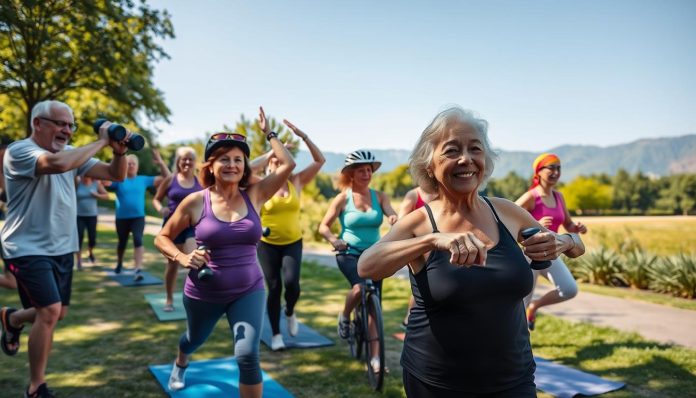As you get older, your body changes in ways that can impact your fitness. To stay fit after 40, you need a smart plan for diet and exercise. It’s possible to keep a healthy and active lifestyle with the right approach.
Knowing what your body needs is key. Making smart choices about what you eat and how you exercise can help. Focus on good nutrition, regular exercise, and enough sleep to stay in top shape. Staying fit after 40 doesn’t have to be hard. With the right mindset, you can reach your fitness goals.
Key Takeaways
- Staying fit after 40 requires a thoughtful approach to diet and exercise
- High-quality nutrition is essential for maintaining physical fitness
- Regular physical activity, such as strength training and cardio, can help combat muscle loss
- Sufficient sleep and hydration are critical for overall health and fitness
- Consulting with professionals, such as personal trainers and nutritionists, can help tailor fitness regimens
- How to stay fit after 40 involves making informed choices about your lifestyle and habits
- Staying active and engaged in physical activity can yield substantial rewards for mental and physical health
Understanding the Importance of Fitness After 40
When you hit your 40s, your body changes a lot. Your metabolism slows down, and you might gain weight. But, regular exercise and a healthy diet can help. They can also lower the risk of health problems that come with age.
Doing at least 150 minutes of moderate activity each week is key. It helps reduce risks for cancer, heart disease, and dying early, no matter your age.
It’s vital to make fitness over 40 a big part of your life. Focus on tips for body maintenance like balance exercises, muscle strengthening, and aerobic activities. Balance gets worse after 25, so it’s important to work on it to avoid falls and injuries.
By focusing on fitness, you can also improve your brain, happiness, memory, and physical health. This leads to a healthier and more active life.
Creating a personal mantra can help you stick to your fitness goals and avoid self-sabotage. Many people find it hard to keep up with fitness plans. But, by linking diet and exercise to your life goals, you can do better.
By making fitness over 40 a top priority and following tips for body maintenance, you can control your health. This sets you up for a happy and healthy future.
The Changing Body and Metabolism
As you get older, your body changes a lot. Your metabolism slows down, and you might gain weight. You could also lose muscle and bone density.
But, regular exercise and a healthy diet can help. They can lower the risk of health problems that come with age. This way, you can stay healthy and active.
Nutrition: Fueling Your Body Wisely
Staying in top shape after 40 means paying attention to what you eat. A balanced diet is key for your body to work its best. It’s important to know about essential nutrients, staying hydrated, and planning your meals.
Essential Nutrients for Over 40s
Research shows that 50 to 60 percent of your daily calories should be carbs for best performance. You should also get 12 to 15 percent of your calories from protein and 20 to 30 percent from fat. Eating a variety of foods from all Five Food Groups is also important.
The Role of Hydration
Drinking enough water is very important, even more so when you’re exercising. You can lose up to 32 ounces of fluid per hour in hot, humid weather. Drinking two to three big gulps of water every 15 to 20 minutes helps keep your strength and endurance up.
Meal Planning for Busy Lives
Eating three meals a day and two to three snacks is good for energy during workouts. Adding high-protein foods like eggs, lean meats, and legumes helps prevent muscle loss and aids in weight control. Choosing nutrient-rich foods can also lower your risk of chronic diseases and help you stay in shape after 40.
Embracing Regular Physical Activity
As you get older, staying fit as you age is key for your health. Regular exercise is vital for maintaining fitness after 40. Andrew Dickens, who trained for a 56km ultramarathon in his 40s, shows that hard work pays off.
Regular exercise can prevent health problems like osteoporosis and heart disease. Aim for 150 to 300 minutes of moderate exercise or 75 to 150 minutes of vigorous exercise weekly. Adding strength, flexibility, and balance exercises can also boost your fitness and lower injury risks.
Make exercise a top priority to control your health as you age. Whether it’s walking, running, or team sports, pick something you like. Remember, maintaining fitness after 40 is a journey. Every step you take is a step towards a healthier, happier you.
Finding Enjoyable Workouts
Starting your fitness journey after 40 is exciting. It’s key to find workouts that make you happy and keep you going. Fitness over 40 is about both physical and mental health. Regular exercise helps you stay healthy, boosts your mood, and gives you more energy.
Choosing activities you love is vital for how to stay fit after 40. You might enjoy walking, jogging, cycling, or group classes like yoga and dance. Research shows that high-intensity workouts lead to better weight loss than other methods.
Discovering New Activities
Trying new things keeps you motivated and stops boredom. You could join a sports team, swim, or rock climb. The most important thing is to find fun activities that make you want to keep going.
Group Classes vs. Solo Workouts
Deciding between group classes and solo workouts is important. Group classes help you meet people and stay motivated. Solo workouts offer flexibility and let you focus on your goals. Choose what works best for you.
Adding physical activity to your daily life and finding fun workouts is key. This will help you reach your fitness goals and live a healthy life. Always drink water, listen to your body, and make fitness over 40 a priority. With dedication and patience, you can become healthier and happier.
Setting Realistic Fitness Goals
Starting your fitness journey means setting goals that fit your life and likes. It’s key to balance fitness with daily habits. Research shows goals keep you motivated and focused. For example, aiming to finish a hard workout or run a distance can boost your drive.
Short-Term vs. Long-Term Goals
It’s important to have both short-term and long-term fitness goals. Short-term goals, like walking more or doing more workouts, build momentum. Long-term goals, like running a marathon, need dedication and hard work. Having both types of goals helps you plan and track your progress.
Tracking Progress Effectively
Keeping track of your progress is key to staying motivated. Use tools like fitness trackers, apps, or journals to monitor your workouts and diet. Regularly checking your progress helps you see what works and what doesn’t. This way, you can adjust your plan to stay on track and reach your goals.
Prioritizing Recovery and Rest
As you aim to stay in top shape after 40, remember that rest is as important as exercise and food. Your body can do great things in your 40s, but it needs time to heal. Rest is not weakness; it’s wisdom. It helps your body fix and grow stronger.
Studies show that exercise and sleep go hand in hand. If you’re having trouble sleeping, moving more can help. And if you’re active, you’ll probably sleep better. This is key for health in your 40s, as bad sleep can cause many problems.
It’s also important to have active recovery days. These can be light activities like yoga or a slow walk. They help your body recover from hard workouts. By listening to your body and resting, you’ll perform better and stay in shape after 40.
Don’t forget, rest and recovery are not extras in a healthy life. They’re must-haves. By focusing on them, you’ll keep your fitness, support your health, and live better.
Incorporating Mindfulness and Stress Management
Staying fit as you age means focusing on both body and mind. After 40, it’s key to use mindfulness and stress management. Mindfulness practices like meditation and deep breathing can lower stress and boost mental health.
Activities like walking or yoga can also cut down stress and lift your mood. By focusing on mindfulness and stress control, you can enhance your overall health. Studies show that small changes in your fitness habits and mindset can lead to better mobility and less pain as you age.
Adding mindfulness and stress management to your daily life helps you stay fit and healthy as you age. Always listen to your body and adjust as needed. If you need help starting, don’t hesitate to seek professional advice.
Staying Motivated and Accountable
As you keep working towards staying fit after 40, it’s key to stay motivated and accountable. Finding a workout buddy who has the same fitness goals is a great way to do this. They can help keep you on track and share the journey with you.
Having a personal trainer, like Steve Halsall for Andrew Dickens, can also be very helpful. They offer the guidance and motivation you need to keep going.
Using fitness apps and technology is another smart move. There are many apps out there that let you track your progress, set reminders, and connect with others who are also working on their fitness over 40 goals. These tools can keep you motivated and on track, even when you’re not with a buddy.
Staying motivated and accountable is vital for keeping fit, more so after 40. By getting a workout buddy and using fitness apps, you can beat the challenges of aging. So, start today by finding a buddy or downloading a fitness app. It will help you stay on track and reach your How to Stay Fit After 40 goals.
Seeking Professional Guidance
When you’re trying to stay fit after 40, getting help from a pro is key. A personal trainer can create a workout plan just for you. They also offer tips for body maintenance and the push you need to keep going. For example, Andrew Dickens and Steve Halsall teamed up to train for an ultramarathon. This shows how important it is to have expert advice for your fitness goals.
A study by Men’s Health highlights the need for structured workouts, recovery time, and balanced intensity. These steps help avoid injuries and keep you moving forward. By following these tips, you can keep fit in a healthy and lasting way.
Benefits of Group Fitness Programs
Group fitness programs are great for staying motivated and feeling part of a community. They also offer support. Plus, talking to a nutritionist can give you tailored advice on tips for body maintenance. They can help you create a diet that matches your exercise plan.
Conclusion: Making Fitness a Lifelong Journey
Staying fit after 40 is more than just keeping your body healthy. It’s about living a full, balanced life. By sticking to a fitness plan, celebrating your wins, and seeing fitness as a lifestyle, you’re set for success. You’ll enjoy a healthy, active life for years to come.
Creating a Sustainable Routine
Being consistent is key for fitness over 40. Start with small, easy changes in your daily life. Try stretching or a quick walk during breaks. Choose activities you love, like bouldering or swimming, to keep you motivated.
Celebrating Your Achievements
Always celebrate your fitness journey’s small victories. Every achievement, big or small, shows your hard work and dedication. Recognize your successes to keep pushing yourself.
Lifelong Fitness as a Lifestyle Choice
Staying fit after 40 is a lifelong promise. See fitness as a core part of your well-being, not just a quick fix. Prioritizing your health boosts your physical and mental well-being.
Your journey to peak shape and optimal health is ongoing. Face challenges, celebrate victories, and enjoy the many rewards of a lifetime of fitness.
FAQ
What are the key tips for staying fit after 40?
To stay fit after 40, eat healthy and exercise regularly. Find workouts you enjoy. Set achievable fitness goals. Make sure to rest and manage stress.
Stay motivated and get help from experts if needed.
How does the body change as we age, and how can we address these changes?
Our metabolism slows down with age, leading to weight gain and muscle loss. Regular exercise and a healthy diet can help. They reduce the risk of health problems.
What are the essential nutrients for maintaining fitness after 40?
Key nutrients include protein for muscle, and enough water. A balanced diet boosts health and energy.
What types of exercises should I focus on after 40?
Focus on strength training, flexibility, and balance exercises. They help keep muscles, joints, and overall function in check.
How can I stay motivated and accountable with my fitness goals?
Find a workout buddy or use fitness apps. Professional guidance from trainers or group programs also helps.
Why is it important to prioritize recovery and rest?
Recovery and rest are key for fitness and injury prevention. Get enough sleep and take active recovery days. Listen to your body.
How can I incorporate mindfulness and stress management into my fitness routine?
Try meditation or yoga. Stress reduction improves physical and mental health.
What are the benefits of seeking professional guidance for my fitness journey?
Professionals offer personalized advice and support. They help you reach your fitness goals more effectively.




